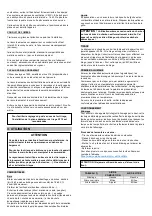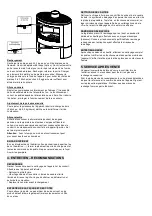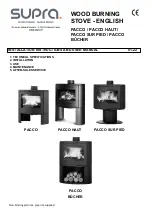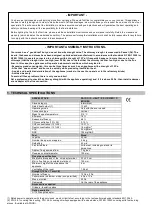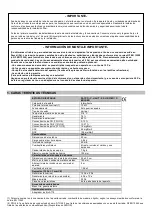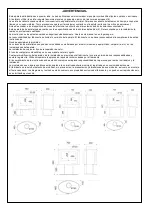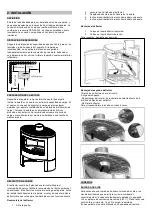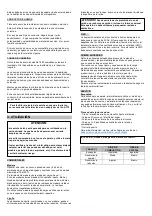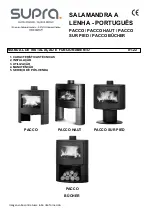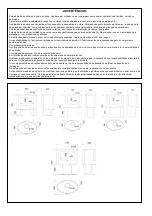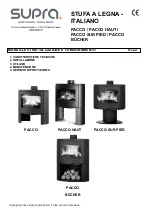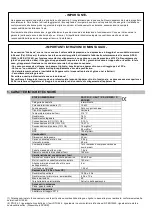
mechanical ventilation system (C. M.V.) It must have a minimum
air passage of 1 dm². Do not operate the stove if a smoke
extractor hood is operating.
This air inlet must be non-blockable, and positioned in the room
where the device is installed.
FLUE PIPE
Treat this point of the installation with great care and attention.
This appliance must not be connected to a shared flue system.
For ducts that are already in place: get it cleaned (mechanical
chimney brush). Get an authorised stove-maker to check its
condition (stability, air tightness, compatibility of materials,
diameter, etc.).
If the flue is not compatible (old, cracked, considerable blockage):
contact a specialist so that it can be repaired in order to comply
with the regulations in force.
CONNECTING PIPES
Use pipes made from enameled T450 stainless steel or 316
stainless steel (available at your stockist), without reducing their
length.
The connection to the flue must be made in the room in which the
appliance is installed. Provide access for chimney sweeping and to
clean the flue pipe. The pipe must not stick out of the flue pipe and
the connections must be removable and airtight.
Maintain a minimum distance of 3 x diameter between the
connecting pipe and the wall.
Avoid having a long horizontal section in front of the flue. If this is
inevitable, then give it a rising slope of 5 cm per metre.
3. USE
FUEL
Wood
Only burn air-dried logs (2 to 3 years, stored in a sheltered and
well-ventilated place) with a maximum humidity of 15 to 20%.
Preferably hardwoods (birch, hornbeam, beech, etc.).
Avoid softwoods (lime, chestnut, willow, poplar).
It is strictly forbidden to permanently use softwoods (pine, fir, etc.)
as well as the use of waste from processed wood (railway
sleepers, woodworking waste, etc.) and household scraps
(vegetables or plastics).
Never use small wood, boxes, woodchips and vine shoots as
these will lead to sudden overheating.
Lignite
Lignite briquettes can be used by themselves or with wood for
slow burning. Place the briquettes in a single layer on a bed of
embers, limited to the surface area of the grid.
DRAUGHT
The hot draught in the flue pipe of the appliance must never be
greater than 20 Pa. Should it be more than this, then install a
draught adaptor. Ask your dealer to measure the draught during
the installation of the appliance. Controlled mechanical ventilation
(CMV) may affect the draught and even reverse it. For this reason,
the CMV must be connected during the measurement of the
draught.
LIGHTING THE FIRE FOR THE FIRST TIME
Remove the self-adhesive labels (except for the nameplate), any
possible blocking cards, and make sure that the ash tray is empty.
Start with a small fire and gradually indcrease the load. This
progressive heating allows the materials to expand slowly and to
stabilise. There may be some fumes and odours, due to the
paintwork. These will gradually disappear. Do this for a few days
until normal use. Open the windows during the first hours of
operation.
When heating up for the first time, check the draught according to
the technical specifications table.
SERVICE
Lighting the fire
To light your appliance, preferably follow the fire lighting procedure
described above. This fire lighting technique makes it possible to
heat up the flue and to remove any blockages (negative pressure)
that may form when the weather is bad or cold, thereby preventing
the air from blowing back into the room when the fire is lit.
The procedure is as follows:
- Put the air combustion control to the maximum setting.
- Place 2 logs on the firebox grid.
- Place the kindling wood in the shape of a tower on top of the
logs.
- Put 1 or 2 fire-lighter cubes on the wood and set alight.
- Close the door.
For further information, view the Supra video on youtube at:
https://www.youtube.com/watch?v=ebOr4vMj2Jo
TABLE (*)
COMBUSTION
AIR
WINDOW AIR
Lighting the fire
Left
Left
Nominal efficiency
Medium
Medium
Reduced efficiency
Adjust
Medium
To facilitate the adjustment of the stove in the event of a
strong draught, the user is recommended to install an
AT15 draught adaptor, as an option.
TAKE NOTE:
This wood burning stove is designed to be used with the
door closed. The door must remain closed except for
refuelling.
To avoid burns, do not touch the appliance and use the
grippers to operate the controls.
The heat emitted through the glass makes it necessary to
maintain a safety clearance with any material that could be
damaged by the heat (furniture, wallpaper, woodwork, etc.).
A 2 m clearance will avoid any risk.
TAKE NOTE!
The use of coal or its derivatives is strictly
prohibited, even on an occasional basis. This appliance must
not be used to burn domestic waste.
TAKE NOTE! Never use petrol, alcohol or fuel-oil, etc.





